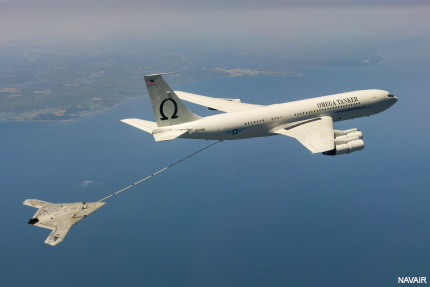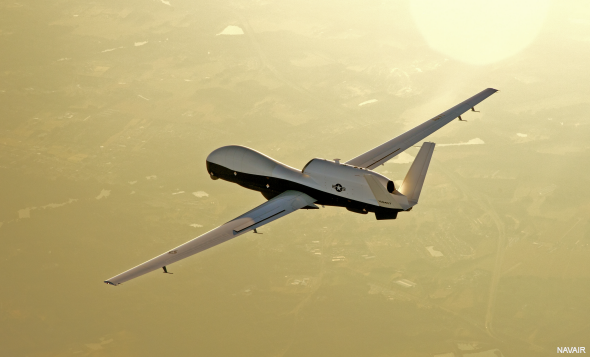Navy extends UAV range with first in-flight refueling
The X-47B becomes the first drone to refuel in flight, while the Triton tests out a more powerful new search radar.

The X-47B receives fuel from an Omega K-707 tanker.
The Navy this month took a couple of big steps toward extending the flight range and intelligence-gathering ability of its unmanned aerial fleet.
The more attention-getting of the two likely was the mid-air refueling last week of the trail-blazing X-47B unmanned demonstration aircraft, which received 4,000 pounds of fuel from an Omega K-707 tanker while flying off the coast of Maryland and Virginia.
About a week earlier, the MQ-4C Triton completed its first flight with a new Multi-Function Active Sensor radar that can deliver a 360-degree view of a large geographic area in all weather conditions, which could do a lot to improve situational awareness at sea.
The refueling effort was the latest—and last—in a series of firsts for the X-47B, which is also was the first UAV to take off from and land on an aircraft carrier. Having demonstrated the possibilities, the X-47B—always intended as a demonstration, rather that operational, aircraft—will now make way for the Navy’s next-generation Carrier Launched Airborne Surveillance and Strike (UCLASS) aircraft.
“What we accomplished today demonstrates a significant, groundbreaking step forward for the Navy," Capt. Beau Duarte, the Navy’s Unmanned Carrier Aviation program manager, said in a news release. “The ability to autonomously transfer and receive fuel in flight will increase the range and flexibility of future unmanned aircraft platforms, ultimately extending carrier power projection."
Refueling in mid-air is tricky enough with manned aircraft, because the pilot has to make precise movements to engage the tanker’s drogue, also called the basket, which delivers the fuel. “Adding an autonomous functionality creates another layer of complexity," Duarte said. The X-47B exchanges messages with the tanker’s Refueling Interface System, then autonomously moved its refueling probe into the tanker’s basket.
The test established that midair refueling is practical, which could extend the range of drone missions, while allowing them to stay in the air longer.
While the X-47B, and the subsequent UCLASS aircraft, are fighters, the Navy also has improved the ISR (intelligence, surveillance and reconnaissance) ability for UAVs with Triton’s flight and the demonstration of the Multi-Function Active Sensor, or MFAS.

The MQ-4C Triton in flight.
The Triton, made by Northrop Grumman and based on the Air Force’s Global Hawk, is intended to provide around-the-clock surveillance anywhere in the world, using a variety of sensors, including an electro-optical/infrared sensor (still images and full video), an electronic support measures package (identify and geolocate radar threat signals) and an automatic identification system (track vessels equipped with AIS responders), in addition to MFAS.
The Triton, scheduled for initial operating capability in 2018, is 47.6 feet long, with a wingspan of 130.9 feet and can fly at up to 60,000 feet and can stay aloft for up to 30 hours. Unless, of course, it gets refueled in midair.
NEXT STORY: Sign up for the Federal IT Acquisition Summit




